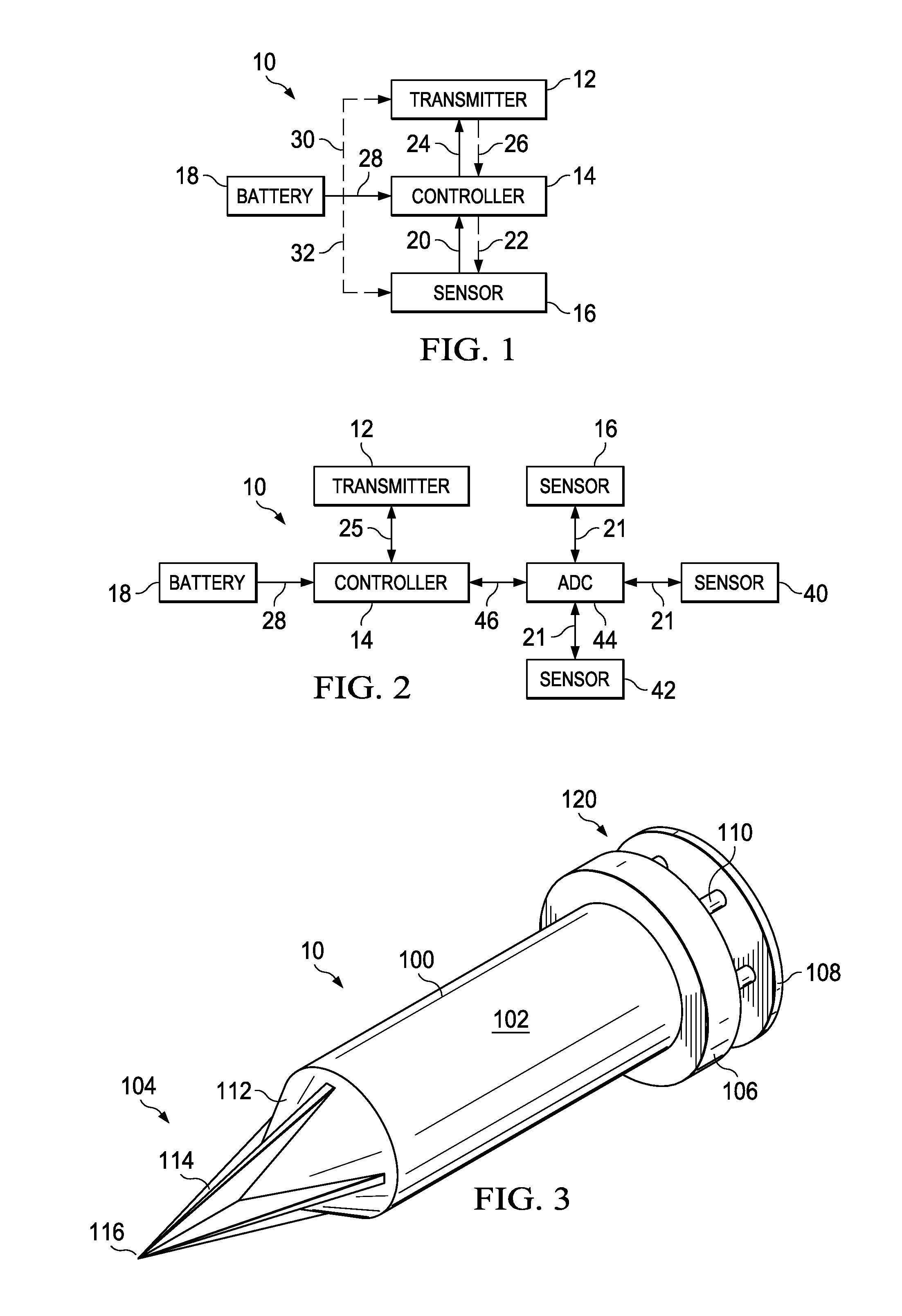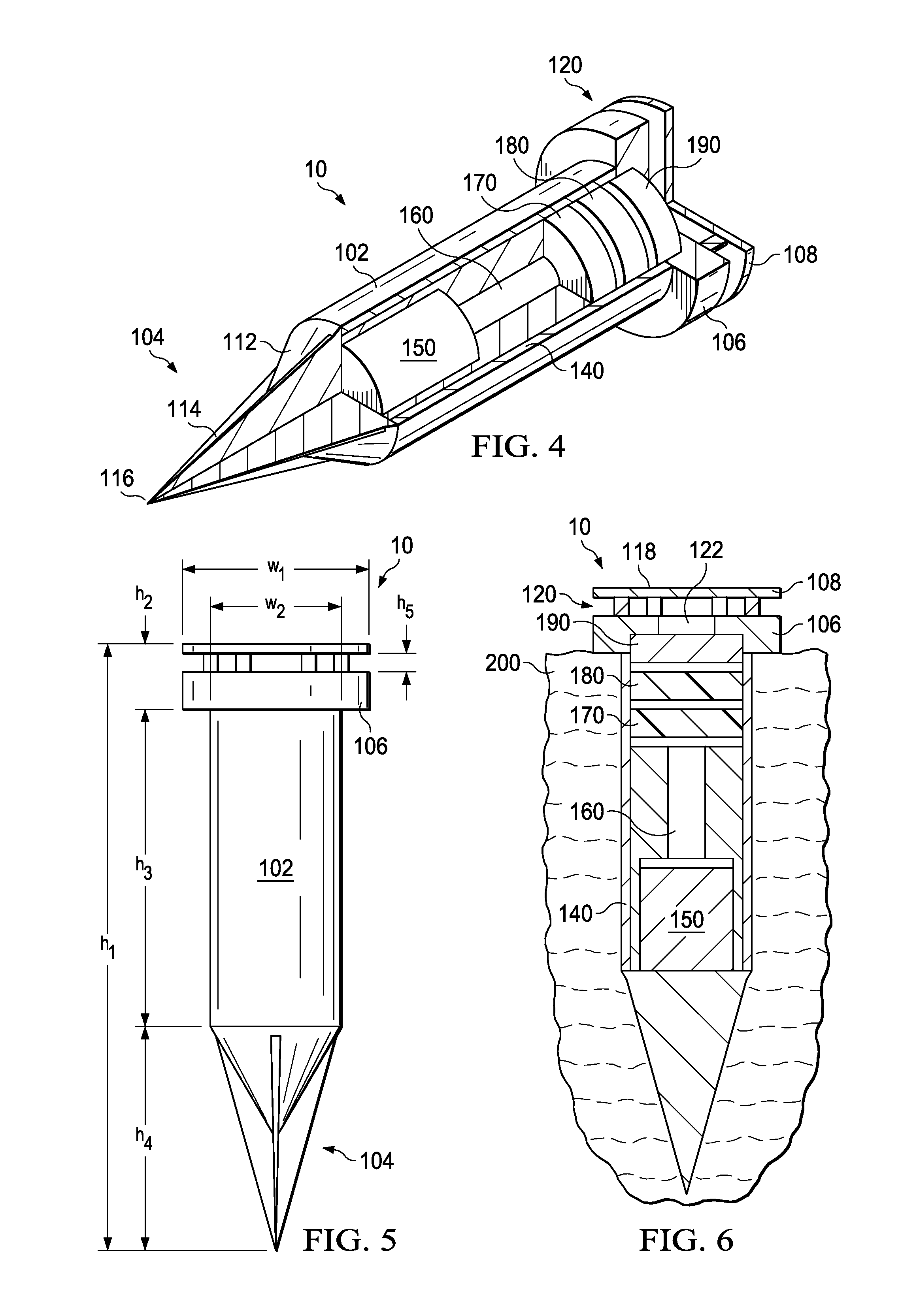[0015]In contrast to prior art systems, an illustrative embodiment provides a small, simple and inexpensive ground sensor that may be used in a network of such sensors. The simplified design of the sensors allows rapid deployment, collection and subsequent redeployment. The lesser expense of the sensors means that loss of individual sensors, either through damage or by inadvertently being left behind, is tolerable.
[0016]The outer body of the ground sensor is shaped to make rapid deployment as easy as possible. In particular, the outer body is shaped to aid pushing the ground sensor into the ground. In this respect, the ground sensor is provided with an elongate outer body that is longer than it is wide. The seismic sensor, the controller and the power supply are housed within the elongate outer body. The
transmitter may also be housed within the elongate outer body. The seismic sensor, the controller, the power supply, the
transmitter (when present within the outer body) and any other components may be stacked one above the other, thus allowing a narrower, longer outer body. Preferably, the
transmitter is located at the top of the stack, e.g., at the top of the outer body. Preferably, the seismic sensor is located at the bottom of the stack.
[0018]With this design, the ground sensors may be pushed easily into the ground. To ensure the ground sensor is inserted into the ground to a desired depth, the elongate body may be provided with a collar at an end of ground sensor remote from base. The collar presents a widened portion, preferably with a flat underside. Thus the collar will provide a stop that prevents the ground sensor being pushed too far into the ground. The transmitter may be positioned at the top of the ground sensor adjacent to the collar such that the transmitter is located
above ground, provided with a suitable
field of view for transmission (e.g., such that the transmission may radiate across the ground rather than be directed mostly upwards).
[0020]Preferably, the ground sensor has a top that is spaced from the collar so as to form an air gap to admit air into interior of elongate outer body. This allows for ventilation and cooling of the components within the ground sensor. The top may be supported above the collar by supports equally spaced around the collar. The height of the ground sensor from the collar upwards, i.e., the portion of the ground sensor exposed
above ground when deployed, may have a low profile thereby increasing covertness. For example, this height may be made to be less than 30 mm, preferably less than 20 mm, with a height of 16 mm being particularly preferred.
[0024]This arrangement provides a denser network of ground sensors. This may be illustrative where low cost sensors are being used. For example, each ground sensor may have a sensitivity in the range of 10 to 20 V / m / s, 12 to 18 V / m / s or 14 to 16 V / m / s. The network may comprise more than 25, 50, 100 or 250 ground sensors. This enables a less expensive network to be created with a greater number of low cost ground sensors. As well as reducing overall cost, this arrangement has a further benefit in providing a network with greater resolution due to the greater number of nodes. Moreover, better opportunities are provided in combining data produced from many more ground sensors, as will be described below.
[0028]This arrangement sees responsibility for
processing and analyzing the seismic data pushed to the
base station, and not imposed upon the ground sensors. This simplifies the requirements for the ground sensors, thus allowing their cost to be reduced. Essentially, data corresponding to the seismic signals is sent from the ground sensors to the
base station, where a processor performs the analysis. It is to be understood that the ground sensors may perform some manipulation of the seismic data, for example to reduce
noise, to amplify the
signal, or to select frequency bands of interest. In any event, the
signal transmitted by the ground sensor still corresponds to the seismic
signal recorded by the seismic sensor. No analysis has been performed at the ground sensor in the sense that no attempt has been made to determine whether an event corresponding to the movement of a
pedestrian or vehicle has occurred.
 Login to View More
Login to View More  Login to View More
Login to View More 


